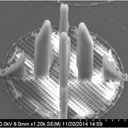Role of cannabinoid receptor type 1 in tibial and pudendal neuromodulation of bladder overactivity in cats.
Keywords
Abstract
The role of cannabinoid type 1 (CB1) receptors in tibial and pudendal neuromodulation of bladder overactivity induced by intravesical infusion of 0.5% acetic acid (AA) was determined in α-chloralose anesthetized cats. AA irritation significantly (P < 0.01) reduced bladder capacity to 36.6 ± 4.8% of saline control capacity. Tibial nerve stimulation (TNS) at two or four times threshold (2T or 4T) intensity for inducing toe movement inhibited bladder overactivity and significantly (P < 0.01) increased bladder capacity to 69.2 ± 9.7 and 79.5 ± 7.2% of saline control, respectively. AM 251 (a CB1 receptor antagonist) administered intravenously at 0.03 or 0.1 mg/kg significantly (P < 0.05) reduced the inhibition induced by 2T or 4T TNS, respectively, without changing the prestimulation bladder capacity. However, intrathecal administration of AM 251 (0.03 mg) to L7 spinal segment had no effect on TNS inhibition. Pudendal nerve stimulation (PNS) also inhibited bladder overactivity induced by AA irritation, but AM 251 at 0.01-1 mg/kg iv had no effect on PNS inhibition or the prestimulation bladder capacity. These results indicate that CB1 receptors play an important role in tibial but not pudendal neuromodulation of bladder overactivity and the site of action is not within the lumbar L7 spinal cord. Identification of neurotransmitters involved in TNS or PNS inhibition of bladder overactivity is important for understanding the mechanisms of action underlying clinical application of neuromodulation therapies for bladder disorders.



